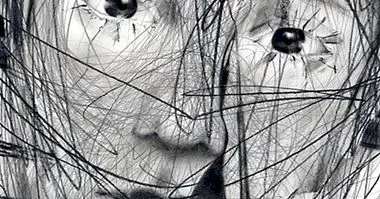Clinical lycanthropy: people who believe they become animals
The figure of the werewolf is a classic of both science fiction and the mythology of different cultures. Since ancient times, human beings have generated figures in which the characteristics of humans and different animals were mixed, considering them from gods (as in ancient Egypt) to products of a curse (in the Middle Ages or even in Ancient Greece).
Also throughout history there have been many people who have claimed to be or become an animal, some living it with real fear. It is believed that many of these people suffered a strange mental disorder called clinical lycanthropy , which we are going to talk about in this article.
- Related article: "What is psychosis? Causes, symptoms and treatment"
Clinical lycanthropy: basic definition
Clinical lycanthropy or licomania is considered a mental disorder characterized mainly by the existence of the hallucination of being or being transformed into an animal . This hallucination is accompanied by the perception of supposed bodily changes, noticing many patients how their physical appearance has varied over time. The shape and size of mouth or teeth or even the feeling that they were shrinking or enlarging has manifested itself in several of the recorded cases. The period in which these people consider to be transformed varies enormously, being able to be comprised between the day and the fifteen years.
Clinical lycanthropy is not limited or does not have to be limited to just one belief, but rather they also maintain typical behaviors of the animals in which they believe to be transformed . Among other behaviors, they can move like them (on four legs, for example), moan or howl, attack or even feed on raw meat.
A strange and little recognized disorder
We are facing a strange and not very usual disorder, of which in fact between 1850 and 2012 one of the authors who has explored the disorder, Blom, has only found thirteen documented cases. Although it is not an internationally recognized disorder given that there are few cases and its symptoms are largely attributable to disorders such as schizophrenia to some psychotic outbreaks , some authors have come to generate some diagnostic criteria. Among them is the fact that the patient claims to be an animal, ensure in a moment of lucidity that sometimes feels being an animal and / or perform behaviors typically animal as mentioned above.
It is important to bear in mind that although technically lycanthropy refers to wolves, people who suffer from this alteration may believe they are transforming into very different animals beyond these. Cases have been detected in which the person believed to be transforming into horses, pigs, cats, birds, toads or even insects such as wasps. Even in some cases it has been recorded that the patient refers to being progressively transformed into different creatures until becoming human again.
- Maybe you're interested: "Hallucinations: definition, causes, and symptoms"
Lycanthropy throughout history
Although there are very few modern cases of clinical lycanthropy that are considered registered and that meet the criteria stipulated by some authors, the truth is that the belief in werewolves is very old and shared by many cultures. Keep in mind that the belief in animistic and totemic elements were much more widespread than today, which explains why most cases and myths date from the old age. But this phenomenon was not always given a spiritual explanation . In fact, there are records that indicated already in the Byzantine era that there was some kind of mental disorder behind some of them.
During the Middle Ages, however, many cases of people who considered themselves or that others considered werewolf were persecuted and burned, considering them in many cases examples of demonic possession. Despite this, even at this time some supposed cases were treated medically (albeit with little success). Probably the high degree of belief in supernatural elements facilitated the expansion of the myth of the werewolf and possibly this could have an impact on the appearance of a greater number of cases.
However, the scientific advances and the progressive decadence of the beliefs regarding magic and spirits were generating that it became increasingly less frequent to believe in the possibility of being possessed and / or being able to transmute into an animal. Cases of lycanthropy have been decreasing over the years, probably for this reason.
The causes of this mental disorder
Clinical lycanthropy is a very rare disorder, with very few cases found throughout the world. It is because of that the investigation of this affectation is minimal , there are no really contrasted theories about the factors that can cause it.
However, the presence of neurological lesions and cognitive impairment associated with the evolution of different diseases (including dementias) could be one of the possible causes: Although the number of known clinical lycanthropy cases is scarce, in two of them some researchers They have been able to obtain images of their brain and records of their brain functioning. The brain records of these two subjects seem to indicate that in the moments in which they believe they are transforming, an anomalous pattern in their cerebral functioning occurs. Regarding the information obtained by neuroimaging, it has been observed the presence of alterations in the regions of the brain that process proprioception and sensory perception, with the somatosensory cortex altered.
Others that different authors have sustained throughout history have exposed that this alteration may be due to some kind of remnant of sociocultural evolution as a species, being frequent in ancient cultures that imitate the wolf or other animals in order to obtain its associated characteristics (strength, speed, fierceness) in order that these will benefit our survival. Those who have such a hallucination could be unconsciously seeking to acquire the qualities of the animals with which they hallucinate, as a way to deal with situations of frustration or stress .
From psychoanalysis has also been explored the vision of transformation as the fact of letting be what we are, said hallucination being a form of avoidance of guilt or conflict coping. It could also arise as a mental maximization of the bodily changes we experience throughout our evolutionary development.
Disorders that are associated
Although licomanía or clinical lycanthropy has special characteristics in relation to other disorders (like the affectation of the cerebral areas that regulate proprioception), it is possible to consider it as a part or symptom of other mental and neurological disorders .
The most frequently associated disorder is the presence of schizophrenia, although the hallucinations in this disorder are usually auditory and not so much kinesthetic and haptic as in lycanthropy. Another affectation that is associated is chronic delusional disorder. In general, it is considered a psychotic disorder . In addition, it has been associated with the experimentation of manic episodes, in which different types of hallucinations can appear.
Bibliographic references
- Blom, J.D. (2014). When doctors cry wolf: a systematic review of the literature on clinical lycanthropy. History of Psychiatry, 25 (1).
- Díaz-Rosales, J.D .; Romo, J.E. & Loera, O.F. (2008). Myths and science: Clinical lycanthropy and werewolves. Bol.Mex.His.Fil.Med; 11 (2).



















